Exclusive: SLI Head-to-Head: Monarch Micro-ATX vs. Shuttle SFF
by Jarred Walton on March 6, 2006 8:56 AM EST- Posted in
- Systems
Shuttle SN26P - Features and Construction
The feature list for the SN26P is virtually identical to the SN25P, as is the construction. Basically, swap out the nForce 4 chipset of the latter and replace it with the nForce 4 SLI chipset, and replace the X1 PCIe slot with an X16 slot, and that summarizes the changes to the features. Here's the complete features table.
All of the required features are present and accounted for. Since this is a true small form factor design, it's limited to two expansion slots, and being SLI capable means that both of them will be used by graphics cards. Unless you wish to resort to external peripherals, your expansion options in the areas of audio, TV tuners, and other PCI-based devices are nonexistent. The use of VIA's Vinyl-24 audio chipset is a relatively good choice, though again for gaming systems, an integrated Audigy or Live! chip would be a better selection. Drivers and gaming performance for other audio chipsets just never quite seem to be as high as the Creative offerings.
Both of these systems are SLI-ready, and as such, it only makes sense that they should be used with two graphics cards. If you don't intend to run two graphics cards, or perhaps a GPU and a PPU (Physics Processing Unit), then there's really no point in considering this particular model. A single high-end graphics card is still generally a better choice than two mid-range graphics cards, at least in my opinion - then you don't have to worry about SLI profiles for a game, and you will usually use less power and generate less heat than having two graphics cards. That's something that we'll look at in the benchmarks.
However, there is one snag with the Shuttle system: due to the smaller case size, installing certain graphics cards like the EVGA 7800 GTX KO is not possible. Actually, it was possible to run a single EVGA KO, but the RAM heat sinks on the back of the card prevented us from installing the second card. Shuttle does rate the system as being capable of supporting everything up through two single slot 7800 GTX cards. Two 7800 GT cards might be a better choice, though, since they don't generate quite as much heat and the cards are very close together. If you do want to install a couple of 7800 GTX cards, we would recommend that you go with models that are not factory overclocked.
Moving on to the construction of the case, the only major change from previous Shuttle P chassis is in the drive rails. The hard drive rails now have clamps on both sides, and the rails for the optical drive are designed such that you install the DVD+RW while the drive cage is removed from the case. Having tested both options, the new design is definitely preferable. It just feels a bit more secure and less prone to damage; though, if you only want to install a single hard drive, you might want to put it in the front mounting position in order to lock down the drive cage.
Summary
I have yet to encounter a Shuttle SFF that I feel is truly a terrible design. The SN26P is no exception: it's well-made, attractive, and easy to work with. However, I do have to wonder if trying to cram multiple GPUs into a SFF case isn't carrying things a bit too far to the extreme. A powerful CPU putting out a decent amount of heat combined with a hard drive and two graphics cards all putting out even more heat, and all living in a small case definitely makes me nervous. I've had 6800 Ultra cards that couldn't run at stock speeds in a large ATX case with ample cooling, and the same goes for some of the factory overclocked 7800 GTX cards. Going with a slightly larger case simply to give the graphics cards more breathing room seems sensible. I didn't experience any difficulties in testing this particular Shuttle, but I was also conducting testing in 70° temperatures. If you live in a warmer climate and you don't have air conditioning, you might have trouble during extended gaming sessions.
The other major issue that I have with the SN26P concerns the price. Perhaps it's the new paint job, but it's difficult to justify spending $250 more than the SN25P just for the opportunity to go SLI. The Monarch Hornet Pro SLI is more capable and starts at about $400 for the case, motherboard, and power supply. Granted, the Revenge Special Edition that we're looking at would be closer to the $580 price of the SN26P - it's actually more like $725 - but the case window, lighting, and vinyl wrap do help justify the cost. You can also have Shuttle build a complete system for you, and when configuring the equivalent of the Revenge, including the three-year on-site warranty, the total comes out to $4000.
You miss out on the added performance of the EVGA KO cards with this Shuttle system, and as mentioned, dual slot GPUs are out (unless you only want to run one graphics card, but then why bother with SLI?). The rumor mill indicates that NVIDIA's upcoming 7900 series will have single slot GPUs, though, so there's a reasonable chance of getting increased graphics performance in the near future into this chassis. To its credit, the Shuttle is a bit quieter than the Revenge and it's definitely smaller, so if size is your primary consideration and you're willing to pay for it, the amount of performance stuffed into this particular SFF is very impressive.
If you want to buy just the barebones SN26P case and add your own parts, you can cut about $800 off the Shuttle P 2600 price, so unlike Monarch Computers, you're definitely paying a large premium to have Shuttle build and configure the system for you. As a barebones system, the SN26P is quite easy to set up and run - easier than the Monarch case, despite the smaller size - and we would recommend interested buyers to go the barebones route. For a "Dream" computer system, the added peace of mind and single point-of-contact support that comes with a fully assembled system might be worth the cost. I wouldn't be willing to pay that much, but then I'm not generally in the market for a $3000+ computer.
The feature list for the SN26P is virtually identical to the SN25P, as is the construction. Basically, swap out the nForce 4 chipset of the latter and replace it with the nForce 4 SLI chipset, and replace the X1 PCIe slot with an X16 slot, and that summarizes the changes to the features. Here's the complete features table.
| Shuttle XPC SN26P | |
| Motherboard: | Shuttle SN26 (NVIDIA nForce4 SLI chipset) - proprietary form factor |
| Processor: | Socket 939 CPU up through FX-60 |
| Heatsink/Cooling: | ICE 4G CPU cooling (80 mm and 60 mm cooling for CPU) Two 40mm fans at rear of case |
| RAM: | Two DIMM slots supporting up to 4GB DDR200 through DDR400 |
| Expansion Slots: | Two X16 slots (X8 data connections) for dual GPUs (SLI bridge included) |
| Expansion Bays: | Two 3.5-inch HDD mounting locations on top One 3.5-inch bay under the 5.25-inch ODD bay (not externally accessible) 8-in-1 Flash Reader |
| Audio: | VIA 24-bit Vinyl Audio 7.1 |
| Power Suply: | Silent X 350W 1 x 8-pin power; 1 x 6-pin power; 1 x 6-pin PCIe with splitter; 3 x SATA; 2 x 4-pin Molex |
| Motherboard Connections: | 1 X FDD 1 X IDE 4 X SATA 3.0Gbps 4 x 4-pin fan headers 8-pin and 6-pin power Parallel port header |
| Front Ports: | 2 X USB2.0; 1 X FireWire (6-pin) 2 X 3.5mm Audio (Headphone and Microphone) |
| Rear Ports: | 4 X USB2.0 1 X FireWire (6-pin) 5 X 3.5mm Audio S/PDIF Optical and Coax Out; Optical In PS/2 Keyboard and Mouse LAN (GbE) |
| Extras: | CMOS Reset button on back Quality paint job |
All of the required features are present and accounted for. Since this is a true small form factor design, it's limited to two expansion slots, and being SLI capable means that both of them will be used by graphics cards. Unless you wish to resort to external peripherals, your expansion options in the areas of audio, TV tuners, and other PCI-based devices are nonexistent. The use of VIA's Vinyl-24 audio chipset is a relatively good choice, though again for gaming systems, an integrated Audigy or Live! chip would be a better selection. Drivers and gaming performance for other audio chipsets just never quite seem to be as high as the Creative offerings.
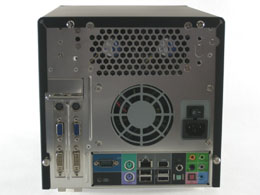 |
 |
| Click on images to enlarge. | |
Both of these systems are SLI-ready, and as such, it only makes sense that they should be used with two graphics cards. If you don't intend to run two graphics cards, or perhaps a GPU and a PPU (Physics Processing Unit), then there's really no point in considering this particular model. A single high-end graphics card is still generally a better choice than two mid-range graphics cards, at least in my opinion - then you don't have to worry about SLI profiles for a game, and you will usually use less power and generate less heat than having two graphics cards. That's something that we'll look at in the benchmarks.
However, there is one snag with the Shuttle system: due to the smaller case size, installing certain graphics cards like the EVGA 7800 GTX KO is not possible. Actually, it was possible to run a single EVGA KO, but the RAM heat sinks on the back of the card prevented us from installing the second card. Shuttle does rate the system as being capable of supporting everything up through two single slot 7800 GTX cards. Two 7800 GT cards might be a better choice, though, since they don't generate quite as much heat and the cards are very close together. If you do want to install a couple of 7800 GTX cards, we would recommend that you go with models that are not factory overclocked.
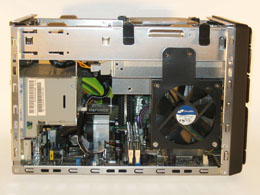 |
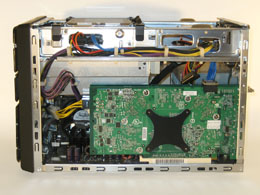 |
| Click on images to enlarge. | |
Moving on to the construction of the case, the only major change from previous Shuttle P chassis is in the drive rails. The hard drive rails now have clamps on both sides, and the rails for the optical drive are designed such that you install the DVD+RW while the drive cage is removed from the case. Having tested both options, the new design is definitely preferable. It just feels a bit more secure and less prone to damage; though, if you only want to install a single hard drive, you might want to put it in the front mounting position in order to lock down the drive cage.
Summary
I have yet to encounter a Shuttle SFF that I feel is truly a terrible design. The SN26P is no exception: it's well-made, attractive, and easy to work with. However, I do have to wonder if trying to cram multiple GPUs into a SFF case isn't carrying things a bit too far to the extreme. A powerful CPU putting out a decent amount of heat combined with a hard drive and two graphics cards all putting out even more heat, and all living in a small case definitely makes me nervous. I've had 6800 Ultra cards that couldn't run at stock speeds in a large ATX case with ample cooling, and the same goes for some of the factory overclocked 7800 GTX cards. Going with a slightly larger case simply to give the graphics cards more breathing room seems sensible. I didn't experience any difficulties in testing this particular Shuttle, but I was also conducting testing in 70° temperatures. If you live in a warmer climate and you don't have air conditioning, you might have trouble during extended gaming sessions.
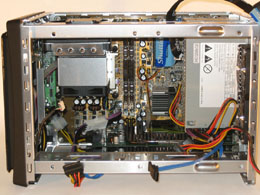 |
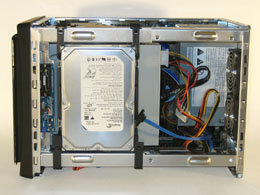 |
| Click on images to enlarge. | |
The other major issue that I have with the SN26P concerns the price. Perhaps it's the new paint job, but it's difficult to justify spending $250 more than the SN25P just for the opportunity to go SLI. The Monarch Hornet Pro SLI is more capable and starts at about $400 for the case, motherboard, and power supply. Granted, the Revenge Special Edition that we're looking at would be closer to the $580 price of the SN26P - it's actually more like $725 - but the case window, lighting, and vinyl wrap do help justify the cost. You can also have Shuttle build a complete system for you, and when configuring the equivalent of the Revenge, including the three-year on-site warranty, the total comes out to $4000.
You miss out on the added performance of the EVGA KO cards with this Shuttle system, and as mentioned, dual slot GPUs are out (unless you only want to run one graphics card, but then why bother with SLI?). The rumor mill indicates that NVIDIA's upcoming 7900 series will have single slot GPUs, though, so there's a reasonable chance of getting increased graphics performance in the near future into this chassis. To its credit, the Shuttle is a bit quieter than the Revenge and it's definitely smaller, so if size is your primary consideration and you're willing to pay for it, the amount of performance stuffed into this particular SFF is very impressive.
If you want to buy just the barebones SN26P case and add your own parts, you can cut about $800 off the Shuttle P 2600 price, so unlike Monarch Computers, you're definitely paying a large premium to have Shuttle build and configure the system for you. As a barebones system, the SN26P is quite easy to set up and run - easier than the Monarch case, despite the smaller size - and we would recommend interested buyers to go the barebones route. For a "Dream" computer system, the added peace of mind and single point-of-contact support that comes with a fully assembled system might be worth the cost. I wouldn't be willing to pay that much, but then I'm not generally in the market for a $3000+ computer.











13 Comments
View All Comments
JarredWalton - Monday, March 6, 2006 - link
HDCP support is a graphics/display issue. As has been reported, HDCP is not supported on any current retail graphics cards. It's also not supported under Windows XP. We should start seeing HDCP enabled cards (meaning, with the necessary decryption chip) in the near future. The GPUs are ready, but they still need the appropriate chip soldered onto the boards.Personally, I'm really not happy with HDCP at all, so I'm doing my best to avoid it. 1280x720 DivX looks quite nice and runs flawlessly on current hardware. Here's an example from the olympics (18GB compressed to 4.5GB 1280x720):
http://images.anandtech.com/reviews/multimedia/tvt...">2006 Olympics Men's Hockey Gold Match
AGAC - Tuesday, March 7, 2006 - link
Hey, what's to love about HDCP. That said, it seems that we just will have to swallow that frog... I mean, DivX does look nice indeed. The problem is availability of mainstream content. I think it's going to be a very cold day in hell before you can walk in the regular video rental and get the latest blockbuster title in beautiful DivX 1280x720.DHCP will be broken, we all know that. It only harms the legal user because one will have to upgrade video cards, monitors and god knows what more will not be HDCP compliant. Thanks for the your tip and simpathy. Keep up the good work.
AGAC
DigitalFreak - Monday, March 6, 2006 - link
NT